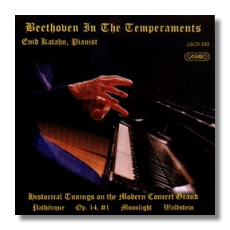
The Internet's Premier Classical Music Source
Related Links
- Beethoven Reviews
- Latest Reviews
- More Reviews
-
By Composer
-
Collections
DVD & Blu-ray
Books
Concert Reviews
Articles/Interviews
Software
Audio
Search Amazon
Recommended Links
Site News
 CD Review
CD Review
Ludwig van Beethoven

In the Temperaments
- Piano Sonata #8, Op. 13 in C minor, "Pathétique" (1798)
- Piano Sonata #9, Op. 14/1 in E Flat Major
- Piano Sonata #14, Op. 27/2 in C Sharp minor, "Moonlight"
- Piano Sonata #21, Op. 53 in C Major, "Waldstein"
Enid Katahn, piano
Gasparo GSCD-332 73:28
Summary for the Busy Executive: Well-tempered.
On the CD jewel case, you can see a sticker: "WARNING: This CD contains pure intervals which may be habit forming!" In other words, this is Beethoven in contemporary tunings, known as "well-tempered." As you may know, our scale divides into twelve basic pitches. However, you may not know that slight adjustments have to be made to this arrangement in order to have chords and intervals sound "in tune." As far as I know, this is true of every tuning system. Our present system of "equal temperament" (the octave divided into twelve equal segments) represents a compromise that allows us to play in all keys with the same degree of "out-of-tune-ness." Yet, even here, the tuner must make small deviations from the purely mathematical increase by the 12th root of 2 for the scales to sound good to our ears, particularly as pitch rises. You might say that, in equal temperament, nothing is truly in tune or that everything sounds equally out of tune. The older system also represents a compromise, however. Here, some keys will sound more "in tune" than others. The keys will differ, of course, depending not only on the tuning chosen, but on the selected base. In any case, this limits a composer's ability to modulate on the piano, where players can't adjust intonation, except crudely and awkwardly, while they perform. Of course, most composers used difficult, left-field modulations, just not, usually, with keyboard music. String players, for example, can adjust pitch simply by moving their fingers slightly, wind and brass players by controlling the pressure from their lips and lungs. We blame a singer for bad pitch. We blame the piano-tuner, rather than the pianist, for an out-of-tune Steinway.
I must say that most advocates of old tuning tend to sound to me like cranks. Music has changed. We can't deny the musical history that has passed since Liszt. It's not a grand conspiracy that has kept down historical tunings, but sheer convenience. Maurizio Pollini probably will not halt his recital for the tuner to change a Beethoven tuning into a Debussy one. Nevertheless, one can make a very strong case for historical tunings on something like the Broadwood fortepiano – for historically-informed performance.
This isn't really the situation here: a well-tempered tuning on a modern Steinway. The defense, proposed by Edward Foote in his extensive liner notes on tuning (most of which I admit I don't understand), is that:
- "Today's modern concert grand is a wonderful instrument for the tonal music of 1800's Vienna. It provides a wider range of expression and power than any of its predecessors";
- Composers of the period went for certain modulatory effects simply lost in equal temperament. Perhaps recorded music in general provides the key to real compromise here, allowing retunings unacceptable in most live modern recitals
One can pick at either or both of these propositions, but such niggling strikes me as beside the point. I will say that Foote, while enthusiastic, is hardly a crank or a pedant. He invites you to hear something you may not have heard before. "It's neat" seems the main appeal. I confess that when I first listened to the CD, I immediately thought of a well-cared-for boarding house piano – perhaps not quite ready for the tuner's ministering hand. The opening to the "Pathétique" in particular cut through with rather an acid bite, nonetheless effective. Unfortunately, I got used to the strangeness of the sound rather quickly and began to focus on the performance as performance. Within a movement, I never did get a contrast in the sound-character of the different keys. In short, whatever magical effects the historical tuning was supposed to work were lost on me.
That said, however, an overwhelming reason to buy this disc sticks around: the playing of Enid Katahn, a pianist previously unknown to me. The tunings I regard as little more than gravy. The meat is Katahn's fabulous musicianship. She plays Beethoven at the level of Schnabel and Serkin. She makes you feel you're inside the composer's mind. Again and again, I caught myself thinking, "This is how the music should go." I put it down to a momentary lapse, since Beethoven's music can "go" a lot of different ways. Still nothing seems over- or underdone. The sheer weight of the sound she gets impressed me. Of course, Beethoven has his lighter moments, and she handles these as well, but she always leaves behind a fundamental seriousness, without pomposity. The "Pastoral" sequence from Disney's Fantasia, silly as it was, nevertheless reflected a pretty valid idea about Beethoven's music: a Goethean idea of classical Greece and classical drama – the marmoreal "objectivity" of Beethoven's tragedy and comedy. That's what Katahn gives you. I was disappointed only by the finale of the "Waldstein," too much on the tame side for my taste.
Nevertheless, a grand recording and a bit of a surprise. The sound is excellent and entirely appropriate: a private room.
Copyright © 2001, Steve Schwartz


















